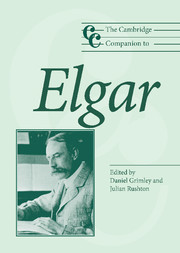Book contents
- Frontmatter
- 1 Introduction
- 2 Elgar and his British contemporaries
- 3 Elgar and his publishers
- 4 Magic by mosaic: some aspects of Elgar's compositional methods
- 5 Elgar's musical language: the shorter instrumental works
- 6 The early choral works
- 7 Elgar's later oratorios: Roman Catholicism, decadence and the Wagnerian dialectic of shame and grace
- 8 Roman Catholicism and being musically English: Elgar's church and organ music
- 9 ‘A smiling with a sigh’: the chamber music and works for strings
- 10 In search of the symphony: orchestral music to 1908
- 11 The later orchestral music (1910–34)
- 12 Elgar's unwumbling: the theatre music
- 13 Elgar and recording
- 14 Broadcasting's ally: Elgar and the BBC
- 15 Elgar in German criticism
- 16 Functional music: imperialism, the Great War, and Elgar as popular composer
- Notes
- Select bibliography
- Index
13 - Elgar and recording
Published online by Cambridge University Press: 28 September 2011
- Frontmatter
- 1 Introduction
- 2 Elgar and his British contemporaries
- 3 Elgar and his publishers
- 4 Magic by mosaic: some aspects of Elgar's compositional methods
- 5 Elgar's musical language: the shorter instrumental works
- 6 The early choral works
- 7 Elgar's later oratorios: Roman Catholicism, decadence and the Wagnerian dialectic of shame and grace
- 8 Roman Catholicism and being musically English: Elgar's church and organ music
- 9 ‘A smiling with a sigh’: the chamber music and works for strings
- 10 In search of the symphony: orchestral music to 1908
- 11 The later orchestral music (1910–34)
- 12 Elgar's unwumbling: the theatre music
- 13 Elgar and recording
- 14 Broadcasting's ally: Elgar and the BBC
- 15 Elgar in German criticism
- 16 Functional music: imperialism, the Great War, and Elgar as popular composer
- Notes
- Select bibliography
- Index
Summary
The size and nature of Elgar's recorded legacy
Elgar first went into a recording studio in January 1914 at the age of fifty-six. In the next twenty years he was to take part in more than fifty recording sessions and leave behind him a recorded legacy of more than fifteen hours as an orchestral conductor.
His earlier recordings, those up to 1925, about a third of the total, were made by means of the acoustic process. In an orchestral acoustic recording session you would have seen thirty or forty men huddled together in front of one or two or occasionally three recording ‘horns’ sticking out from the wall, capturing the sounds. There would be only a handful of violinists, perhaps six in all, and probably only a single cellist, who would be mounted on a platform which could be moved back and forth, nearer or further away from the recording device. The flutes and clarinets and oboes would be sitting immediately behind the small body of strings, but if the first flute or the first clarinet had a solo, he – invariably he – would stand up and gingerly but quickly make his way through the strings and lean forward within a few inches of the mouth of the horn. Bassoonists would often be seated opposite the violinists with the horn players mounted on platforms high behind them with their backs to the conductor so that the bells of their instruments were directed at the recording horns.
- Type
- Chapter
- Information
- The Cambridge Companion to Elgar , pp. 184 - 194Publisher: Cambridge University PressPrint publication year: 2005



